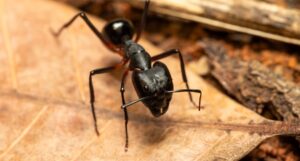Carpenter ants can be a nuisance, causing damage to wooden structures in homes and buildings. When dealing with an infestation, many people wonder if ant traps are effective against these particular pests. In this blog post, we will give the answer to that question and also explain the traps that work highly against the carpenter ants.
Do Ant Traps Work for Carpenter Ants?

Ant traps can be useful for controlling carpenter ants; however, they may be less efficient than other treatments. Carpenter ants are more likely to be drawn to protein-based baits than sweet baits, which are usually used in ant traps. Also, carpenter ants have large colonies, so the infestation may not be completely eliminated by trapping a single carpenter ant.
What Type of Traps Work on Carpenter Ants?
When dealing with carpenter ants, it’s crucial to use traps specifically formulated for them. The traps that are mostly effective against carpenter ants are,
- Baits with Boric Acid: Carpenter ants are attracted to sweet and protein-based baits containing boric acid or similar insecticides.
- Gel Baits: Gel baits are effective in attracting carpenter ants and can be applied in cracks and crevices where ants are likely to travel.
- Granular Baits: Granular baits can be spread around the perimeter of the home or near suspected entry points to intercept foraging ants.
- Bait Stations: Bait stations offer a controlled environment for carpenter ants to feed on poison bait, which they then carry back to the colony.
- Liquid Baits: Liquid baits can be applied in areas where ants are active or along ant trails to attract and eliminate foraging workers.
Difference Between Carpenter Ants and Ants

Carpenter ants belong to the same family as other ants but have distinct characteristics that set them apart.
- Size: Carpenter ants are typically larger than other common ant species, with workers ranging from about 6 to 12 millimeters in length, while regular ants are generally smaller.
- Nesting Habits: Carpenter ants nest in wood, excavating galleries within damp or decaying wood, while many other ant species build their nests in soil, under rocks, or in other protected locations.
- Diet: Carpenter ants do not eat wood but instead feed on a variety of foods, including insects, honeydew, and sweet substances. In contrast, some ant species may primarily forage for food sources like sugars, proteins, or fats.
- Appearance: While carpenter ants share some physical similarities with other ants, they often have a distinctive appearance, with a larger size, dark coloration, and sometimes reddish or yellowish hues, depending on the species.
Conclusion
While regular ant traps may not always be effective against carpenter ants, customized traps created especially for these pests can be useful tools in infestation control. Understanding the differences between carpenter ants and other ant species and how to properly check for signs of an infestation can help us easily detect these pests, and with the help of pest control services, we can easily eradicate them from our personal space.






